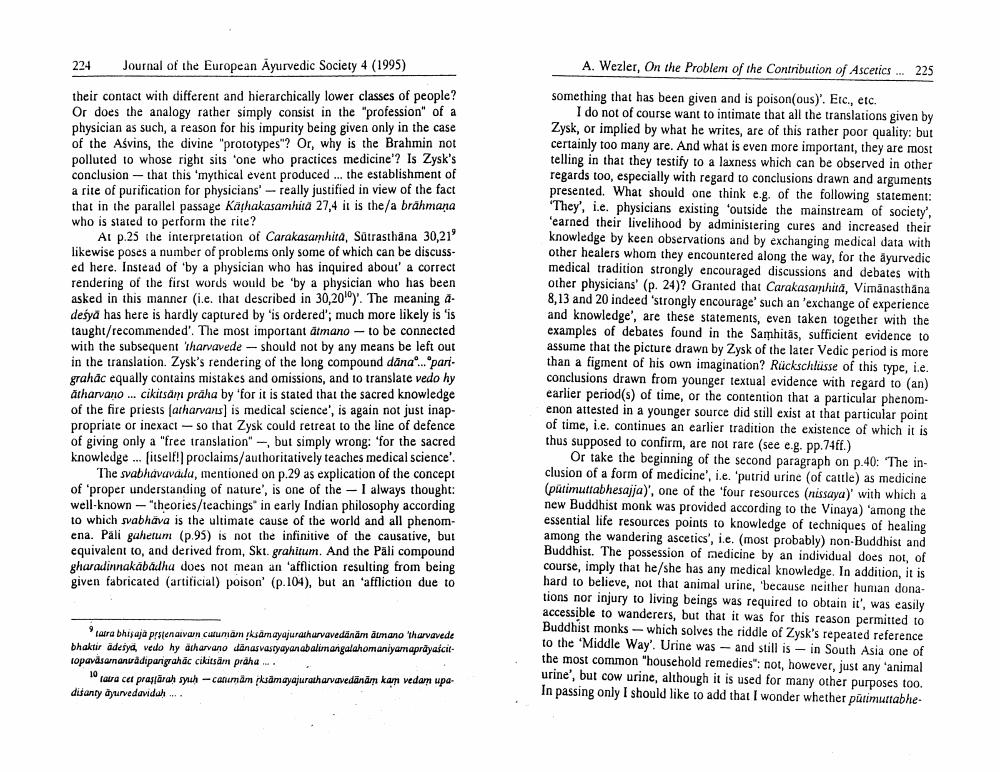________________
224
Journal of the European Ayurvedic Society 4 (1995)
A. Wezler, On the Problem of the Contribution of Ascetics ... 225
their contact with different and hierarchically lower classes of people? Or does the analogy rather simply consist in the "profession" of a physician as such, a reason for his impurity being given only in the case of the Asvins, the divine "prototypes"? Or, why is the Brahmin not polluted to whose right sits 'one who practices medicine'? Is Zysk's conclusion that this 'mythical event produced ... the establishment of a rite of purification for physicians' really justified in view of the fact that in the parallel passage Kathakasamhita 27,4 it is the/a brahmana who is stated to perform the rite?
Al p.25 the interpretation of Carakasamhita, Sätrasthana 30,21 likewise poses a number of problems only some of which can be discuss ed here. Instead of 'by a physician who has inquired about' a correct rendering of the first words would be 'by a physician who has been asked in this manner i.e. that described in 30,20). The meaning - desya has here is hardly captured by 'is ordered'; much more likely is 'is taught/recommended'. The most important atmano-to be connected with the subsequent tharvavede - should not by any means be left out in the translation. Zysk's rendering of the long compound dana...par grahdc equally contains mistakes and omissions, and to translate vedo hy Atharvano ... cikitsdini praha by 'for it is stated that the sacred knowledge of the fire priests (arharvans) is medical science, is again not just inappropriate or inexact - so that Zysk could retreat to the line of defence of giving only a "free translation" - but simply wrong: 'for the sacred knowledge ... litself! proclaims/authoritatively teaches medical science'.
The svabhavuvau, mentioned on p.29 as explication of the concept of proper understanding of nature', is one of the -I always thought: well-known - "theories/teachings in early Indian philosophy according to which svabhäva is the ultimate cause of the world and all phenomena. Pali guherum (p.95) is not the infinitive of the causative, but equivalent to, and derived from, Skt. grahitum. And the Pali compound gharadinnakabadha does not mean an 'affliction resulting from being given fabricated (artificial) poison' (p.104), but an affliction due to
something that has been given and is poisonous)'. Etc., etc.
I do not of course want to intimate that all the translations given by Zysk, or implied by what he writes, are of this rather poor quality, but certainly too many are. And what is even more important, they are most telling in that they testify to a laxness which can be observed in other regards too, especially with regard to conclusions drawn and arguments presented. What should one think e.g. of the following statement: "They. i.e. physicians existing outside the mainstream of society. 'earned their livelihood by administering cures and increased their knowledge by keen observations and by exchanging medical data with other healers whom they encountered along the way, for the dyurvedic medical tradition strongly encouraged discussions and debates with other physicians' (p. 24)? Granted that Carakasamhita, Vimanasthana 8,13 and 20 indeed strongly encourage' such an 'exchange of experience and knowledge', are these statements, even taken together with the examples of debates found in the Samhitas, sufficient evidence to assume that the picture drawn by Zysk of the later Vedic period is more than a figment of his own imagination? Rückschlusse of this type, i.e. conclusions drawn from younger textual evidence with regard to (an) earlier period(s) of time, or the contention that a particular phenomenon attested in a younger source did still exist at that particular point of time, i.e. continues an earlier tradition the existence of which it is thus supposed to confirm, are not rare (see e.g. pp.74ff.)
Or take the beginning of the second paragraph on p.40: The inclusion of a form of medicine, i.e. putrid urinc (of cattle) as medicine (putimuttabhesajja)', one of the 'four resources (nissaya)' with which a new Buddhist monk was provided according to the Vinaya) among the essential life resources points to knowledge of techniques of healing among the wandering ascetics', i.e. (most probably) non-Buddhist and Buddhist. The possession of medicine by an individual does not, of course, imply that he/she has any medical knowledge. In addition, it is hard to believe, not that animal urine, 'because neither human donations nor injury to living beings was required to obtain it', was easily accessible to wanderers, but that it was for this reason permitted to Buddhist monks - which solves the riddle of Zysk's repeated reference to the Middle Way'. Urine was- and still is - in South Asia one of the most common "household remedies": not, however, just any 'animal urine', but cow urine, although it is used for many other purposes too. In passing only I should like to add that I wonder whether putimuliabhe.
Tatra bhis aja prstenarvarn cutumam samgyajurahurvavedänām amano tharvavede bhaktir adesya, vedo hy diharvano danasvastyayanibalimarigalahomaniyamaprdyascit. topavasarnanuddipangrahāc cikisām praha...
cara ca prasārah syuh - Canimam kamayajuratharvavedänām kan vedam upadisanty ayurvedawdah...




